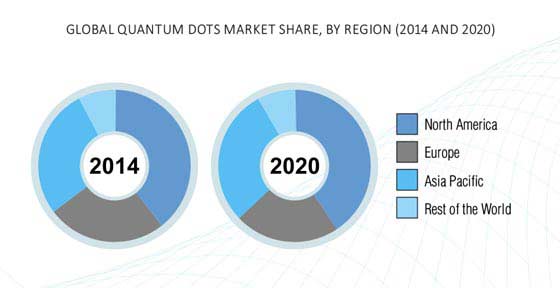Rising Expansion of Electronics Sector Fuels Quantum Dots Industry
Quantum dots are known as artificial atoms. These are widely used for commercial and clinical applications. The quantum dots possess unique fluorescent and electronic characteristics, including high photochemical stability, narrow emission spectra, and continuous absorption spectra. Their small size and high surface area with such electrical and optical characteristics make them ideal for biotechnology and biomedical applications.
The quantum dots industry is projected to rise in the coming years, and it is ascribed to the rising requirement for quantum dots in high-quality display devices, worldwide in the electronics industry. Some favorable macroeconomic factors include the rising interest of people in advanced technology and rising disposable income.
Under the material segment, the quantum dots industry is segmented into cadmium sulfide (CdS), cadmium selenide (CdSe), indium arsenide, cadmium telluride (CdTe), and others. The CdSe category leads the industry. It is ascribed to the fact, that electroluminescence and photoluminescence emission caused due to CdSe quantum dots.
CdSe quantum dots are used in various applications such as color modifiers for LEDs, color display, low-threshold lasers, optical fiber amplifiers, and self-assembled photonic sphere arrays.
Under the type segment, the quantum dots industry is categorized into healthcare, optoelectronics, renewable energy, optics, and security & surveillance. Among these, the optoelectronics category dominates the industry. It is ascribed to the worldwide expansion of the electronics industry, which resulted in massive demand for quantum dots.
APAC is projected to experience the fastest growth in the industry. It is ascribed to the rising application of quantum dots technology in countries such as India, South Korea, China, and Japan. Furthermore, the deployment of quantum dots in mobile displays, energy storage systems, mobile displays, medical devices, and solid-state lighting solutions boosts the industry.
The worldwide rising display-based electronics industry fuels the demand for quantum dots. Over the last few years, the electronics industry has fuelled the display industry, it resulted in substantial demand for quantum dots.
In addition, the high demand for tablets, personal computers, and smartphones propels the requirement for quantum dots in Europe, APAC, and North America.
In addition, surging disposable income and improving the quality living standards of people in emerging economies, such as India, China, and Brazil create opportunities for the expansion of the quantum dots industry.
In APAC, most electronic products are manufactured in Japan, China, and South Korea. Therefore, the demand for tablets, smartphones, and television is rising at a substantial rate. It results in massive demand for quantum dots.
Furthermore, rising power requirement in the region results in energy-efficient technology and photovoltaic industry propulsion, which boosts the demand for quantum dots.
The major players operating in the industry are; Quantum Materials Corporation, QD Laser Inc., Ocean Nanotech LLC, Nanoco Group PLC, Invisage Technologies Inc., NN-LABS LLC, and QD Vision Inc.
The expansion of the electronics sector results in quantum dots industry propulsion.
Read More:
https://www.psmarketresearch.com/market-analysis/quantum-dots-marketRising Expansion of Electronics Sector Fuels Quantum Dots Industry
Quantum dots are known as artificial atoms. These are widely used for commercial and clinical applications. The quantum dots possess unique fluorescent and electronic characteristics, including high photochemical stability, narrow emission spectra, and continuous absorption spectra. Their small size and high surface area with such electrical and optical characteristics make them ideal for biotechnology and biomedical applications.
The quantum dots industry is projected to rise in the coming years, and it is ascribed to the rising requirement for quantum dots in high-quality display devices, worldwide in the electronics industry. Some favorable macroeconomic factors include the rising interest of people in advanced technology and rising disposable income.
Under the material segment, the quantum dots industry is segmented into cadmium sulfide (CdS), cadmium selenide (CdSe), indium arsenide, cadmium telluride (CdTe), and others. The CdSe category leads the industry. It is ascribed to the fact, that electroluminescence and photoluminescence emission caused due to CdSe quantum dots.
CdSe quantum dots are used in various applications such as color modifiers for LEDs, color display, low-threshold lasers, optical fiber amplifiers, and self-assembled photonic sphere arrays.
Under the type segment, the quantum dots industry is categorized into healthcare, optoelectronics, renewable energy, optics, and security & surveillance. Among these, the optoelectronics category dominates the industry. It is ascribed to the worldwide expansion of the electronics industry, which resulted in massive demand for quantum dots.
APAC is projected to experience the fastest growth in the industry. It is ascribed to the rising application of quantum dots technology in countries such as India, South Korea, China, and Japan. Furthermore, the deployment of quantum dots in mobile displays, energy storage systems, mobile displays, medical devices, and solid-state lighting solutions boosts the industry.
The worldwide rising display-based electronics industry fuels the demand for quantum dots. Over the last few years, the electronics industry has fuelled the display industry, it resulted in substantial demand for quantum dots.
In addition, the high demand for tablets, personal computers, and smartphones propels the requirement for quantum dots in Europe, APAC, and North America.
In addition, surging disposable income and improving the quality living standards of people in emerging economies, such as India, China, and Brazil create opportunities for the expansion of the quantum dots industry.
In APAC, most electronic products are manufactured in Japan, China, and South Korea. Therefore, the demand for tablets, smartphones, and television is rising at a substantial rate. It results in massive demand for quantum dots.
Furthermore, rising power requirement in the region results in energy-efficient technology and photovoltaic industry propulsion, which boosts the demand for quantum dots.
The major players operating in the industry are; Quantum Materials Corporation, QD Laser Inc., Ocean Nanotech LLC, Nanoco Group PLC, Invisage Technologies Inc., NN-LABS LLC, and QD Vision Inc.
The expansion of the electronics sector results in quantum dots industry propulsion.
Read More: https://www.psmarketresearch.com/market-analysis/quantum-dots-market



